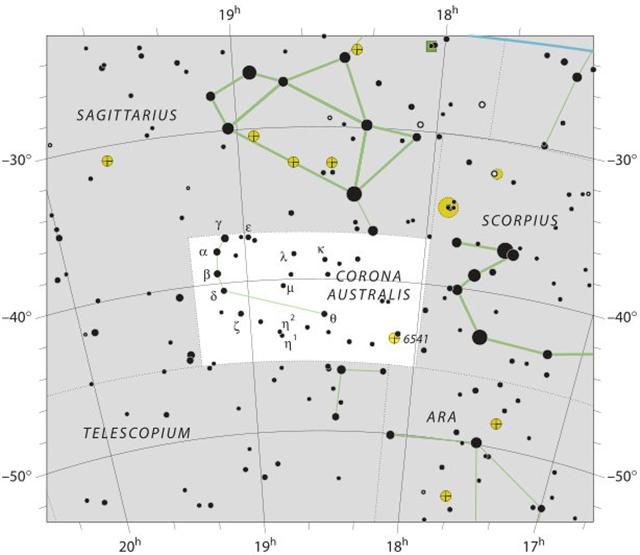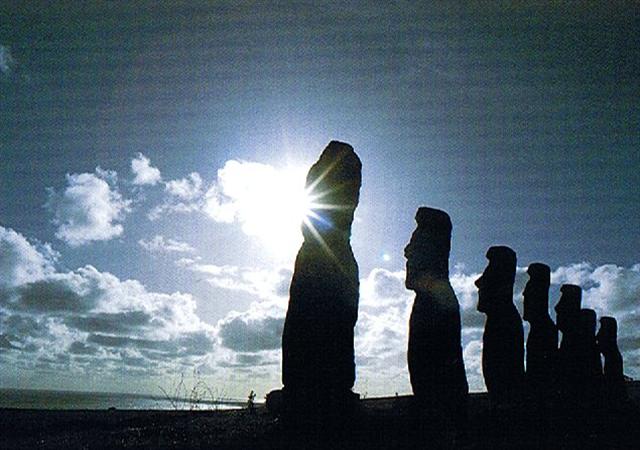4.
Corona
Australis
marks
the
beginning
of Sun's
path up
from the
Tropic
of
Capricorn,
where
the new
year is
beginning:
 |
 |
 |
 |
 |
| Ga8-21 |
Ga8-22 |
Ga8-23 (*290) |
Ga8-24 |
Ga8-25 (229) |
| λ Lyrae (287.7), Ascella (287.9), Nunki (288.4) |
ζ Cor. Austr. (288.5), Manubrium (288.8), γ Cor. Austr. (289.3), τ Sagittarii (289.4) |
ι Lyrae (289.5), δ Cor. Austr. (289.8), Alphekka Meridiana, Al Baldah (290.1), β Cor. Austr. (290.2) |
Aladfar (291.1) |
Nodus II (291.5), ψ Sagittarii (291.6), θ Lyrae (291.8) |
| 'January 3 |
19h (289.2) |
'5 (370) |
'6 |
'7 |
| Shaula begins. |
2 |
3 |
4 |
5 (236) |

There is a curve of stars here, resembling the curve of stars at the end of Scorpius. The glyph type hau tea possibly illustrates this kind of phenomenon. The canoe of the explorers described a curve when approaching Easter Island (see at Hanga Te Pau):
... Pau is the key word, and it is probably alluding to Puna Pau (cfr top left on the first map):
| Pau
1. To run out (food, water): ekó pau te kai, te vai, is said when there is an abundance of food or water, and there is no fear of running out. Puna pau, a small natural well near the quarry where the 'hats' (pukao) were made; it was so called because only a little water could be drawn from it every day and it ran dry very soon. 2. Va'e pau, clubfoot. Paupau: Curved.
1. Hakapau, to pierce (cf. takapau, to thrust into). Pau.: pau, a cut, a wound, bruised, black and blue. 2. Resin. Mq.: epau, resin. Ta.: tepau, gum, pitch, resin. (Paupau) Hakapaupau, grimace, ironry, to grin. 3. Paura (powder), gunpowder. 4. Pau.: paupau, breathless. Ta.: paupau, id. 5. Ta.: pau, consumed, expended. Sa.: pau, to come to an end. Ma.: pau, finished. 6. Ta.: pau, to wet one another. Mq.: pau, to moisten. |
The basic idea seems to be 'finished' (out of breath, out of water). Thus Hanga Te Pau could mean the harbour at the end of the journey. The last words on page 17 are he vari ki hanga.te pau:
| this is Te Pito O Te Kainga, which also received its name from the dream soul. |
ko te pito o te kainga i nape ai e toona kuhane. |
p. 17 |
| The canoe continued its exploration and in a sweep sailed on to Hanga Te Pau. |
hokoou.he rarama he oho te vaka he vari ki hanga.te pau |
| They went ashore and took the food with them. |
he tomo ki uta.he too i te kai ki uta. |
| p. 18 |
| They pulled the canoe onto the beach and left it there. |
hee totoi i te vaka ki uta he hakarere. |
Vari means a curve and also paupau means a curve. Possibly a curve is a sign of approaching end. Old people no longer have straight backs ...
|
The hanau type of glyph signifies 'birth' and the star Aladfar is η at the eastern wing of the 'Golden Plover' of Lyra:
 |
 |
| Ga8-24 |
hanau |


All the great stone statues (moai) of Easter Island have their faces inward, looking towards the interior of the island - excepting those 7 at Ahu Akivi who are looking out towards the sea in the west.

This exceptional Sign of reversal seems to be the same as that of the Lyra bird who also is looking towards the west. Though the moai of Ahu Akivi are oriented towards equinox and not towards solstice (see at The Scapegoat).
Number 222, the current right ascension day of the star Toliman, clearly implies 'birth', but hanau in Ga6-17 has a maro string hanging down which means 'final'. Thus it probably means the 300 fertile days of Sun are in the past (no more 'births'):
 |
 |
 |
 |
60 |
| Ga6-16 |
Ga6-17 (158) |
Ga6-18 |
Ga6-19 |
| ρ Bootis (219.5). Haris (219.7), σ Bootis (220.2), η Centauri (220.4) |
ρ Lupi (221.0), Toliman (221.2) |
Yang Mun (222.1) |
ο Bootis (222.9), Izar (223.0) |
|
| 'October 27 (300) |
'28 |
'29 |
'30 |
60 |
| 164 |
165 |
166 |
167 |
60 |
 |
 |
 |
 |
| Ga8-17 |
Ga8-18 (222) |
Ga8-19 |
Ga8-20 (*287) |
| λ Cor. Austr. (283.6), Double Double (283.7), ζ Lyrae (283.8), φ Sagittarii (284.1) |
μ Cor. Austr. (284.6), η Cor. Austr. (284.8), Sheliak, ν Lyrae (285.1) |
Ain al Rami (286.2), δ Lyrae (286.3) |
Alya (286.6), ξ Sagittarii (287.1), ε Cor. Austr., Sulaphat (287.4) |
| 'December 30 (364) |
'31 |
'January 1 |
'2 |
| 228 |
229 |
230 |
Qalb al Akraab ends (231). |
... the Chinese name Yang Mun (South Gate) for α Lupi agrees with Nan Mun (South Gate) for α Centauri (elsewhere named Toliman by me) ...
|













